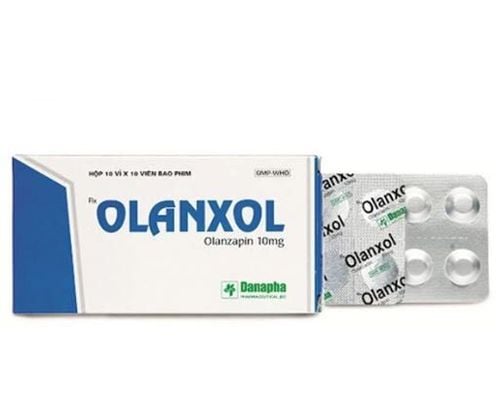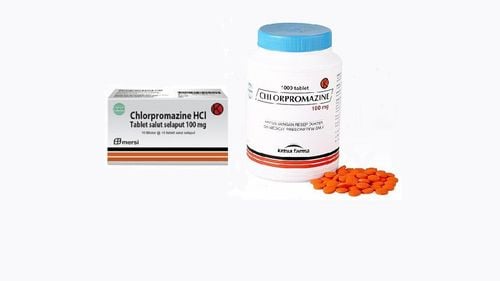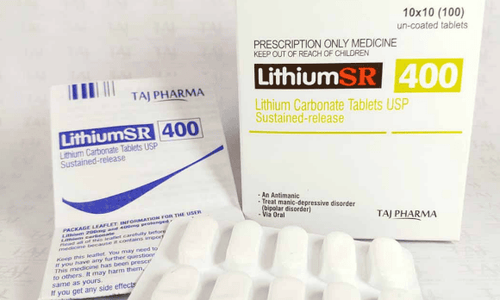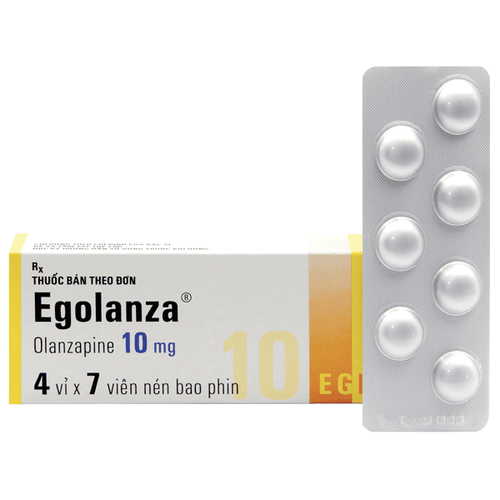This is an automatically translated article.
Olavex 10mg is a neuroleptic drug with the main active ingredient being Olanzapine. Olavex 10mg is used in the treatment of schizophrenia, bipolar disease, manic psychosis monotherapy.
1. What is Olavex 10mg?
Olanzapine is an atypical antipsychotic, a derivative of dibenzodiazepine. Olanzapine has many different pharmacological properties than typical antipsychotics, which are derivatives of butyrophenone or phenothiazines, such as less prolactin secretion, less extrapyramidal syndrome, and tardive dyskinesia with prolonged treatment. In addition, Olanzapine is effective on both negative, positive and inhibitory manifestations of schizophrenia.The antipsychotic effects of Olanzapine have a complex mechanism and have not been fully elucidated. The mechanism of action of the drug is related to the antagonism of Olanzapine at serotonin type 2 (5-HT2A, 5-HT2C), type 3 (5-HT3), type 6 (5-HT6) and dopamine receptors in the brain. central nervous system. Olanzapine has an inhibitory and down-regulatory effect (negative regulator) to the 5-HT2A receptor, which is related to the drug's antimanic effects.
In addition, Olanzapine stabilizes mood by partially blocking dopamine D2 receptors. Olanzapine has an antagonistic effect on muscarin receptors (M1, M2, M3, M4 and M5). Olanzapine's anticholinergic effects, in addition to explaining the reduced risk of extrapyramidal syndrome, are also associated with several other side effects of Olanzapine. Olanzapine also has an antagonistic effect on alpha-1 adrenergic receptors and histamine H1 receptors, this effect is related to the potential for postural hypotension and somnolence when using the drug.
2. Indications and contraindications Olavex 10mg
Olavex 10mg drug is used in the treatment of the following conditions:
Schizophrenia, bipolar disease: used in manic or mixed exacerbations, rapid cycling bipolar disease, acute agitation due to schizophrenia or bipolar disease. Monotherapy of manic psychosis in adults and children 12-18 years of age (administered under close medical supervision). This drug is not contraindicated in patients who are allergic or hypersensitive to Olanzapine and breast-feeding women.
3. How to take Olavex 10mg
3.1 How to take Olavex 10mg is taken orally, the drug can be taken with meals or away from meals. Patients with persistent somnolence can take the daily dose at bedtime.
Dosage of Olavex 10mg must be carefully adjusted for each patient. The lowest effective dose of Olavex should be used, the dose is gradually increased and divided into several times a day at the beginning of treatment to help reduce unwanted effects.
3.2 Dosage In schizophrenia patients, the recommended starting dose of Olavex is 10mg/day. Manic episodes: Initial dose is 15 mg once daily for monotherapy, or 10 mg/day for combination therapy. Prevention of Bipolar Disorder: The recommended starting dose is 10 mg/day. For patients already receiving Olanzapine for manic episodes, continue with relapse prophylaxis at the same dose. If a new manic, mixed, or depressive episode develops, olanzapine therapy should be continued (at optimal dose if needed), with add-on therapy to treat mood symptoms as clinically indicated. During the treatment of manic episodes, schizophrenia and the prevention of relapse of bipolar disorder, the daily dose for the next day may be adjusted depending on the clinical condition of each patient. 5-20mg/day. Dose increments larger than the recommended starting dose should be made only after appropriate clinical reassessment and usually over a period of at least 24 hours. Children: Due to the lack of data on the safety and efficacy of Olanzapine in children and adolescents under 18 years of age, Olavex 10mg is not recommended in this population. According to several short-term studies, weight gain, prolactin and lipid changes occurred more frequently in adolescent patients than in adult patients. Elderly: A lower starting dose (5 mg/day) is not routinely indicated but should be considered in patients over 65 years of age when clinical factors permit. Renal and hepatic impairment: A lower starting dose (5 mg/day) should be considered for this patient. In patients with moderate hepatic impairment (Child-Pugh A or B cirrhosis), start with 5 mg/day and need to be cautious when increasing the dose. Fatal overdoses in patients are commonly observed with doses of Olanzapine above 200 mg. Symptoms of overdose usually appear within 1 - 2 hours, the drug effect reaches its maximum effect within 4-6 hours: agitation, tachycardia, dilated pupils, anticholinergic, muscle spasticity, symptoms extrapyramidal symptoms, increased salivation, epilepsy, neuroleptic malignant syndrome...
Management of drug overdose Olavex 10mg: Symptomatic treatment, supportive care, maintenance of intravenous line Monitor vital signs and heart function. Eliminate and limit absorption of the drug remaining in the gastrointestinal tract by gastric lavage with activated charcoal and sorbitol. There is currently no specific antidote for Olanzapine. Peritoneal dialysis and hemodialysis have a very limited role in the treatment of acute olanzapine poisoning.
4. Some notes when taking Olavex 10mg
Olavex is indicated for the treatment of schizophrenia, in combination with the treatment of mania for pediatric patients aged 12-18 years under the close supervision of a specialist. Children 13-17 years of age are at greater risk of weight gain and hyperlipidemia than adults. Therefore, before using Olanzapine, long-term risk assessment and detailed treatment plan should be considered.
Elderly patients with dementia-related psychiatric disorders: Olanzapine should be used with caution due to the increased risk of mortality, mainly from infectious (pneumonia) and cardiovascular (insufficiency) causes. heart, sudden death). Elderly female patients using the drug are at increased risk of tardive dyskinesia. In the event that occurs, the possibility of discontinuation of the drug may be considered.
Patients with a history of epilepsy, head trauma, or taking medications with the potential to lower the seizure threshold should use olanzapine with caution because dose-dependent convulsive effects may occur during treatment. .
Neuroleptic malignant syndrome (NMS): When the patient develops symptoms of this syndrome, Olavex 10mg should be discontinued.
Patients with benign prostatic hypertrophy, angle-closure glaucoma or a history of paralytic ileus due to the anticholinergic effects of olanzapine should be used with caution.
Patients with cardiovascular disease, cerebrovascular disease, pathology potentially causing hypotension (dehydration, hypovolaemia, being treated with antihypertensive drugs): Using Olavex increases the risk of hypotension Postural pressure associated with bradycardia, syncope, and sinus node arrest. Before using Olanzapine, it is necessary to determine the risk factors for venous thrombosis and to apply preventive measures.
Olavex has the potential to reduce concentration and motor activity related to the sedative effect of the drug.
Patients with diabetes, hyperglycemia: Olanzapine has a risk of causing hyperglycemia, even uncontrolled even after stopping the drug. Monitor blood sugar during treatment.
Patients with liver failure or patients being treated with hepatotoxic drugs: it is necessary to periodically check transaminase levels during the use of Olavex 10mg.
Abrupt discontinuation of Olavex 10mg may cause acute symptoms such as sweating, tremors, anxiety, insomnia, nausea or vomiting.
Olanzapine can cause drowsiness, dizziness. Do not drive or operate machinery when these side effects occur while taking this medicine.
Lactation: Olanzapine is excreted in human milk and causes CNS depression in the infant. Avoid the use of Olavex in women who are breastfeeding or not breast-feeding when administering the drug to the mother.
5. Undesirable effects when using Olavex 10mg
Central nervous system: extrapyramidal syndrome, insomnia, somnolence, dizziness, nightmares, dysphonia, euphoria, forgetfulness, mania. Increased photosensitivity, epilepsy, neuroleptic malignant syndrome. Digestive: dyspepsia, increased appetite, dry mouth, nausea, vomiting, constipation. Liver: increased liver enzymes. Musculoskeletal: muscle weakness, tremor. Cardiovascular: hypotension, peripheral edema, chest pain, tachycardia or bradycardia, QT interval prolongation. Endocrine, metabolic: hypercholesterolemia, hyperprolactinemia, hyperglycemia. Discontinue use of Olavex in case of symptoms of neuroleptic malignant syndrome. Patients after the onset of this syndrome should choose the drug less likely to cause the syndrome and gradually increase the dose for the patient.
6. Drug interactions
Levomethadyl should not be used concurrently with Olanzapine due to the increased risk of cardiotoxicity (QT prolongation, torsades de pointes, cardiac arrest) Metoclopramide: Concomitant administration of Olanzapine increases the risk of extrapyramidal and sedating syndromes. malignancy. Central nervous system depressants such as alcohol, benzodiazepine derivatives increase the orthostatic hypotensive effect of Olanzapine. CYP450 inhibitors (cimetidine, caffeine, ciprofloxacin, erythromycin, quinidine, antidepressants such as fluvoxamine) increase blood levels of olanzapine and therefore may increase its effects and toxicity. Inducers of CYP450 (carbamazepine, phenobarbital, phenytoin, omeprazole, rifampicin, nicotine) decrease the blood concentration of Olanzapine. Dopamine, adrenaline or other beta-adrenoceptor-like agents: use in patients receiving olanzapine therapy for worsening of hypotension due to olanzapine's alpha-blocking effect. These drugs should not be used concurrently with Olanzapine. Olanzapine enhances the effect of anticholinergic drugs, increasing the antihypertensive effect of antihypertensive drugs. Medicines to treat Parkinson's: Olanzapine may decrease the effects of these drugs.
Please dial HOTLINE for more information or register for an appointment HERE. Download MyVinmec app to make appointments faster and to manage your bookings easily.













